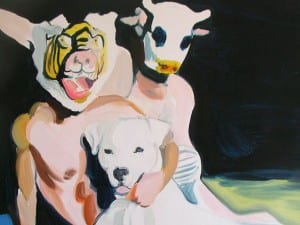Makoto Takigawa’s inspirations arise from observations made while in natural surroundings. His paintings explore time’s progression through endless movement with his brushstrokes and colours. Aesthetica talk to the artist about the inspiration behind his practice and the impressions made through his artworks.
A: Your work is incredibly expressive, with bold colours sweeping through a play of light. Could you discuss your technique in terms of painting – how you approach a piece and what you hope to achieve?
MT: I usually have a certain image or color scheme in mind before I start a painting. But soon after I begin, my intuition takes over and becomes its own process. I hope to achieve some sense of this mood and atmosphere in my paintings.
A: Could you talk about how nature influences your work – as you dig for fossils in Wyoming – how does this act as a catalyst to creating pieces?
MT: When I’m exposed to nature out in the field, I become very aware of my senses that are usually dulled by filtering the noises of daily life in the city. Painting nature is a reminder to myself of that sense of being.
A: Do you think your works have a purpose or a narrative at all – do you think they need one?
MT: My work is a very personal interpretation of nature. The purpose is to present to the audience my view of this. I don’t know if my body of work needs a narrative, but some people may see a story within it.
A: As nature is so widely observed across a range of media – both commercial and artistic – how do you think your work is set apart from others in terms of aesthetics or audience response?
MT: Whenever you present your personal view to the masses, it tends to bring more criticism than approval. I’m risking this by not presenting images that may be the most appealing to the general public. But the responses I get from viewers tends to be very strong and personal. Because of that, I think taking this risk is well worth it.
A: Could you talk about the personal experience you’re trying to evoke with your viewers through the artwork?
MT: Even though my work is a very personal interpretation of the subjects, having a mostly abstract style can open up a kind of conversation between the viewers and I. It is as though I start telling the story and the viewers decide how to end it, or keep creating their own stories.
A: How does the element of time tie into your works?
MT: Time represents movements and progression to me, which is an important element in my painting. To capture just one moment out of never-ending movements in nature seems to be a very static image in my mind. Instead, I’m trying to convey my overall impression of the moment.
A: There is a sense of movement in the canvasses – how do you think the process of brush strokes helps to create fluidity?
MT: What I’m trying to achieve with my brush strokes is to have movements depicted in such a way that every time you view my painting, you discover something new that you didn’t see the first time. As I paint over hours, even by days, my mood changes and my senses are affected differently by time. This is transferred to the canvas in layers and textures and I hope the viewers can experience that through my artwork.
To find out more about Takigawa’s work: www.takigawastudio.com
Credits:
1. Makoto Takigawa, Sunset Oil on canvas 122cm x 91.5cm (2016). Courtesy of the artist.





